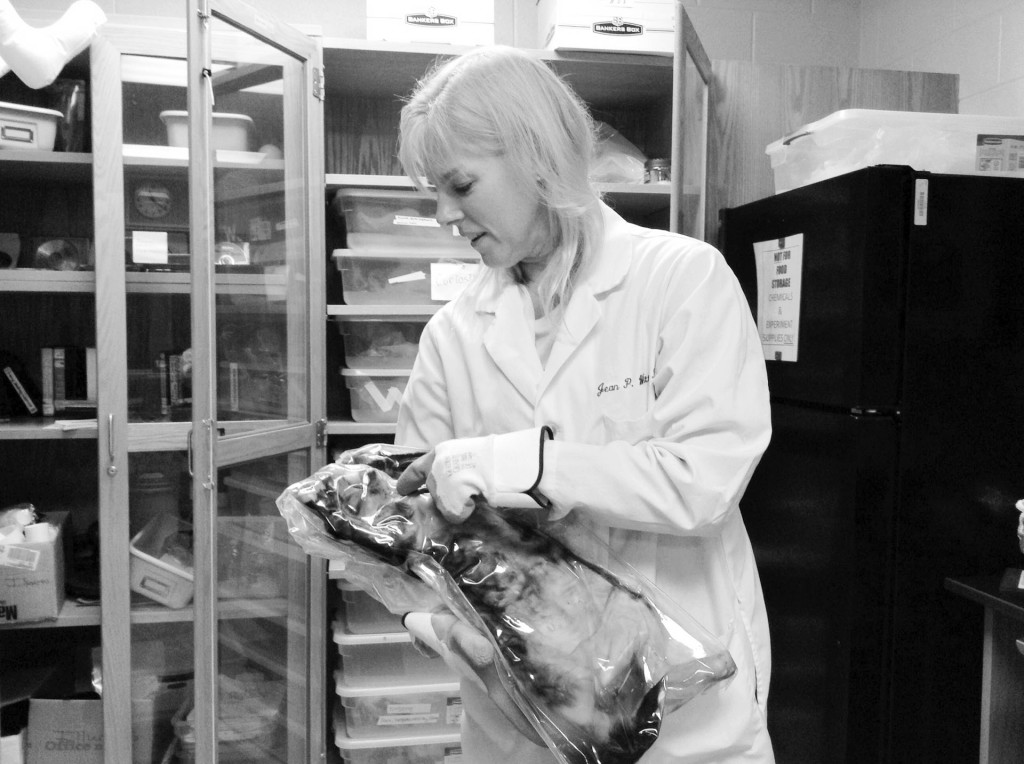
You could smell it before you could see it.
Science teacher Jean Witty picked up Eugene and his lifeless body sagged in the plastic bag. Eugene’s body had not been skinned…yet. She spoke a few words about him, put him back onto the shelf and locked up the closet. Even though air fresheners were present, they did not hide the smell of formaldehyde reeking from the cat’s body.
Many students taking science courses participate in dissection. For the last four years, Anatomy and Physiology classes have dissected cats.
“I think that [dissecting the cat] is definitely a good way to familiarize yourself with the different body systems,” said senior Emily Westel. “A lot of the ways the cat’s body is made up is not that different from the ways our bodies are made up.” For example, after learning about cancer, the students identified a tumor on one of the cat’s legs, Witty said.
Students also have a chance to name their cats.
“One of the really cute ones this year was named ‘Curiosity’ because of the [phrase] ‘Curiosity killed the cat,’” Witty said.
Witty makes sure to inform her classes about the origin of cats like Curiosity. The cats are distributed to the school from Carolina Biological Supply Company.
According to Keith Barker, product safety and compliance manager at Carolina Biological Supply Company, the company does not work with any living animals but obtains them from government-operated or regulated, humane animal shelters.
Barker said that the cats are “euthanized at the shelter under the shelter’s policies. They would have been bound for a landfill or incinerator had [the company] not purchased them.”
To ease into the dissection, Witty said that she introduces the topic early in the year.
“We talk about the dissection as part of the class right from the first day,” said Witty. “I usually get out one of the cats so the students can see it. I have had us pass the cat around by making a big circle and everybody touches it the first day. It’s in its baggy, but I think it’s really important for them to see and realize that [dissection is] part of the course.”
Mary Rockrohr, instructional supervisor of sciences, said one of the purposes of the class is to “build career interests…for anything medical.”
According to Witty, most of the students in her anatomy and physiology classes are interested in pursuing medicine. “Having taught [dissection] for four years now, some of the students that I have had in the first or second year are now in pre-med or in a nursing program at major universities,” said Witty. “I heard back from them about how glad they are that they took the course. …To give our students that experience is worthwhile.”
Westel is one of the students interested in going into the medical field.
“[Dissection] is giving potential, future medical students an opportunity to learn and grow in their knowledge,” Westel said.
Senior Natalie Buchholz said she is an animal activist and is “against animal dissection unless [students use it] for pre-professional use” and that otherwise, “it’s very unnecessary and it’s a waste of life.”
Buchholz plans on becoming a veterinarian or a veterinary chiropractor and understands that dissection will be common for her in the future. However, she believes students who are not interested in medical careers should choose alternative methods of dissection.
Witty suggested methods such as reading the textbook, being a lab assistant, watching an online video or using a virtual cat dissection. She said that teachers are “flexible” about students who do not feel comfortable with dissection.
“I’ve had some people who have come up to me in the beginning and said, ‘I have a couple of [black] cats at home, I don’t think I could dissect a cat that’s black,’” said Witty. “And I say, ‘That’s fine! Let’s get you one that’s gray and white.’”
Rockrohr believes that if the teachers are flexible, the students are too and protests are uncommon.
“I understand,” said Witty. “You wouldn’t want to be made to be in a place where you were made to feel uncomfortable, ever.”
According to Witty, dissection provides a unique, new perspective of the body.
“As you begin to look at it more, you appreciate the marvelous ways that the body is put together,” said Witty. “Thinking of [dissection] as that learning tool, …you realize how intricate the body is.”

